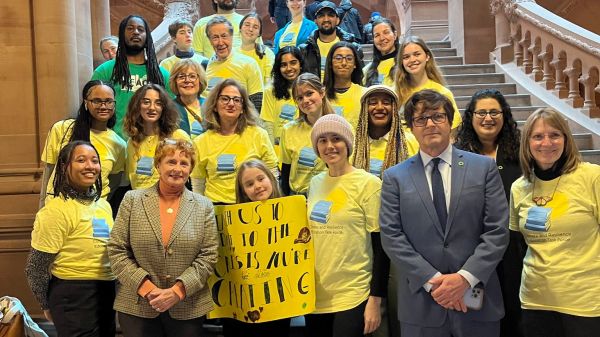Climate Education and Intergenerational Civic Engagement: A Case Study in New York

Welcome to our EE and Civic Engagement mini-blog series! This series highlights key insights from a panel discussion hosted by Cornell University and the NAAEE ee360+ program in May 2024. Each post will feature one panelist, sharing their segment of the webinar along with a thoughtful essay that expands on their ideas. Stay tuned for more!
This essay was written by Emily Fano is the Senior Manager for Climate Resilience Education at the National Wildlife Federation. A published author and experienced climate leader, Emily specializes in the design of whole community climate resilience education and teacher training programs including the Resilient Schools and Communities (RiSC) program. Emily is also the founder of the Climate & Resilience Education Task Force, an intergenerational coalition of educators, students, NGOs, and community members working to expand access to climate education across New York State.
In 2023, a series of critical climate events underscored the urgency of the situation, including unprecedented ice loss in high latitudes and potential ecosystem collapses in the Amazon and other regions. This was also the hottest year on record. Education plays a crucial role in mitigating this crisis by empowering climate-literate citizens who support sustainable policies and choose careers that help mitigate climate change. Research has shown that scaling up climate education could reduce carbon emissions comparably to large-scale interventions like electric vehicles or rooftop solar (http://doi.org/10.1371/journal.pone.0206266).
Despite the pressing need, most K–12 students in New York and throughout the U.S. receive inadequate climate education. They are often limited to no more than two hours of climate-related instruction per year, typically provided in advanced placement “Environmental Science” classes taken by less than 7% of students. This education largely overlooks crucial areas such as climate resilience, adaptation, and the broader spectrum of sustainable career opportunities. Currently, New Jersey stands out as the first state that mandates comprehensive climate literacy across all grades and subjects.
The complexity of the climate crisis calls for a holistic educational approach that includes systems thinking to understand its causes, impacts, and potential solutions. However, New York’s educational framework lacks the comprehensive, interdisciplinary curriculum needed to support its climate goals under the New York’s Climate Leadership and Community Protection Act (CLCPA), which aims for zero-emission electricity in New York by 2040. This gap in education highlights a generational injustice and undermines the state's capacity to meet its climate objectives.
The Climate & Resilience Education Task Force (CRETF), established in 2018 by the National Wildlife Federation and now co-managed with WE ACT for Environmental Justice, has developed a comprehensive plan for statewide climate education (https://www.cretf.org/our-vision). This initiative calls for updated curricula, enhanced teacher training, and the establishment of specialized programs in green technologies, aligning with New York's potential as a leader in the offshore wind and community solar sectors.
Youth activism in recent years has placed climate change at the forefront of civic engagement. It is inspired by an increasing number of people who name climate change as a top issue of concern and who support a transition to renewable energy. In this critical time, it is important to help students advocate for climate change education through rallies, meetings with elected officials, and other means. Thus, the CRETF is calling for comprehensive climate education, as highlighted by the following challenges:
- Over 40 million students annually face educational disruptions due to climate impacts.
- A majority of young people are increasingly anxious about their futures in a warming world.
- Teachers are eager to educate about climate issues but often lack the necessary training.
- Students are keen to learn about climate solutions, yet current standards tend to focus only on the problem.

